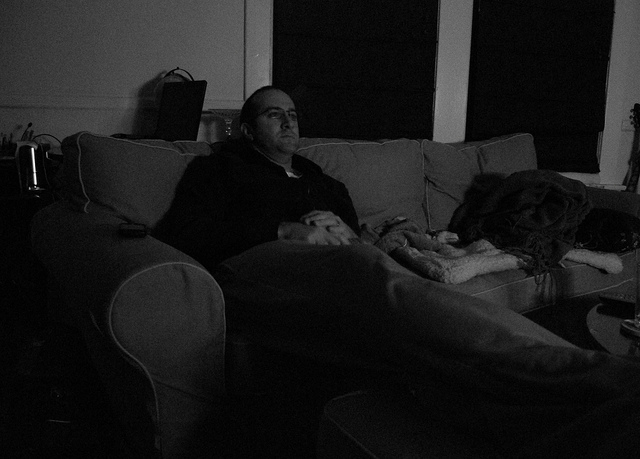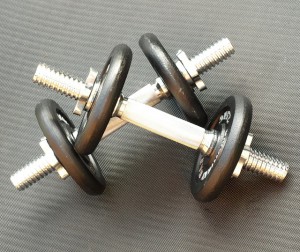I’ve referred to this progressive overload a few times now in previous articles, but not everyone has come across this concept before. This principle is essential to seeing any positive changes in your body through exercise, but what does “progressive overload” mean exactly, when it comes to fitness training?
In this article you’ll find out more about the basics behind this very important principle, find out if you’re making the one crucial mistake that will stop you from ever seeing any results from your training, and how to make sure that you are training with progressive overload so that you too can see changes to your physique, strength or ability.
(Okay… I acknowledge that some of us might exercise for the health benefits, but I’m not ashamed to admit that one of my main drivers is cos I wanna look good!)
What is Progressive Overload?
Progressive overload is a principle used in fitness training that involves a gradual increase in demands placed on the body in order to increase strength, endurance, and power.
The increased stress placed on the body is the key to triggering a response by the body, which then works to synthesize and strengthen the cells and tissues required so that it can meet these new demands being placed on it. 
You do this step-by-step in order to reach your maximum potential, which may be limited by genetics or your physical limits.
This simple concept is absolutely key in all exercise, and the foundation of weight training and body-building as we know it. Summarized differently: The body is lazy and only adapts to what it absolutely needs to in order to survive. You can use this to your benefit or your disadvantage, as you’ll find out from the following examples.
Human Bodies are Highly Adaptable….
Since the body adapts to demands that you place upon it, you can train your body to be stronger and more able. A nice side effect of this is that as you stack on the muscle, your body looks better too ;).

This is where progressive overload comes into play. Increase the demands you place on your body, and it will respond to meet those demands as best as it can. If you’re performing tasks which require a lot of muscle strength to do efficiently, then your body will start to optimize and grow those muscles in response.
…But they are also Lazy
Unfortunately, being highly adaptable also means our bodies only do the bare minimum that they have to in order to get by.

The bad news of this is that if you spend most of your days as a slovenly couch potato, your body will eventually adapt to the fitness demands that being a couch potato entails – nada. Sedentary or inactive people can actually lose muscle at an alarming rate.
NASA have studied this principle in action as well, with their astronauts experiencing up to 20% total body muscle loss in as little as 5 – 11 days in space due to zero-gravity. Without the demands that gravity places on muscles, the body doesn’t bother to keep those muscles around.
Applies to More Than Just Muscle
Progressive overload doesn’t just work for getting bigger and stronger muscles. This principle also applies to connective tissues, bone, cardiovascular fitness and flexibility, and the concept even stretches out into nutrition and digestion as well.
The body is smart and it will always optimize to meet the stimulus you provide it!
Why Most People Fail at Changing Their Bodies

This one mistake is unbelievably common, and it all stems from not understanding how progressive overload works.
My dad is a bit of an ‘exercise freak’, but in the whole time I’ve known him, he’s never changed his body shape or physique as a result of his training. “I want to bulk up” he told me in a recent conversation, and so I asked him what his workout routine is like.
To his credit, it’s very involved, though bordering on obsessive! Not including warming up and cooling down exercises, he ends up doing at least 1 hour of cardio a day as well as a further hour on the weight machine, and trains different muscle groups on alternating days so that he’s working out anywhere between 5-7 days of the week.
So with this 10-14+ hours per week of exercise, why hasn’t he seen any changes in his body?
He Makes the One Crucial Mistake Most People Make With Fitness Training
The answer is simple – he never increases the weight, makes it harder, or changes his routine. I asked him how he’d been training since he started. The routine was exactly the same 6 months on! Remember how the body adapts only as much as it has to? His has gotten good at doing his particular workout routine, but that’s it.
It’s all too common – people who go to the gym, do the exact same routine, and never see any results. Especially if you are investing a decent amount of time working out, it can be very frustrating not to see any tangible results or improvements.
Key Principle:
If you want to improve, you need to make exercising difficult so that your body needs to adapt to keep up, hence the ‘overload’ in ‘progressive overload’.
How to Use ‘Progressive Overload’ in Your Workout Routine
You need to beat your previous workout in some way, so that you increase the demands placed on your body. When you do this, then you will start to see your body change and adapt to become stronger and more able to perform the exercises you are demanding of it.
Here are just a few ways you can achieve progressive overload in your workout routine:
- Add or increase resistance (by using weights or a resistance band)

- Do more repetitions
- Do the exercises with more intensity (e.g. more mental focus on activating muscles, at a faster rate, or with more explosive power)
- Take less rest between exercises (you could also ‘pre-fatigue’ muscles)
- Do different exercises that you are not used to
A good rule of thumb is that if it’s comfortable, you’re not working hard enough. A difficult workout is one that will get you the results that you want.
This can often be as much of an exercise for the mind as it is for the body, especially if you’re not used to ‘pushing through’ when it starts to get difficult or muscles start to ache and burn. Having strong willpower is a must for this, otherwise you fall into the trap of only exercising comfortably, and when that happens….. guess what? You’re no longer implementing progressive overload.
Progress Your Way To Success
 To summarize, the concept of progressive overload is fundamental to anyone who wants to create physical changes in the way their body looks or functions.
To summarize, the concept of progressive overload is fundamental to anyone who wants to create physical changes in the way their body looks or functions.
Always make sure you are increasing the demands that you place on your body if you want to keep seeing positive changes. Little by little, you can improve until you get to your goals.
Though this can be difficult, a key mistake is to keep working out at the same level of difficulty. Though this will allow you to maintain your body function where it is at, it will not allow you to improve.
I hope you found this article on progressive overload helpful. I’m interested to hear if you incorporate progressive overload into your own workout routine, or are you happy to just maintain your level of fitness where it currently is at?


My wife and I are working out together now and really appreciate the information you share on this site.
Thanks Dan! Glad to hear you are working out together, it’s great to have a workout buddy, even better when it’s your spouse!
love the website name and a great article. I don’t know where you got the pic of me sitting on the couch though.
Hahaha, nice one Ship 🙂 I’m sure we’ve all been there at some point… the challenge is to not spend too much time in that spot!
This makes so much sense. I never heard of the term progressive overload before but I do agree that in order to get results, you need to stretch your boundaries. Thanks for this great article.
Hi Wendy, I was doubtful writing this post as I thought everyone would have already known about this topic! I’m glad to hear that you got something out of it. Cheers for the feedback 🙂
Hmph damn lazy body. I didn’t know astronauts lost muscle that quickly. Now I have even less reason to want to go out into space.
I agree on the need to change up your workout routine after a while, because of the adapting body we have. Partly the reason I don’t like when people go to the gym and spend a lot of time on treadmills or cross trainers.
I always write down what I am doing as well, so that I know by the numbers if I have improved and by how much. Nice simple explanation you have given here
Great tip, I sometimes rely on memory and whether or not the same workout feels ‘easy’ or not, but when I was doing weightlifting at the gym I kept a log of weights, reps and sets. It’s also super motivating to look back and see your improvements!
A really interesting read this. I have been quite a fit person all my life and my work in the past has depended on it. I always looked at fitness as something I tried to maintain and never thought about pushing this progressive overload.
I always thought I was fir enough but when I read this it really gave me a new way to look at things.
Thanks for the info
Chris
Hi Chris, great to hear that you take good care of your health and fitness, unfortunately not many people do, so great job! If you haven’t been pushing your limits, you’re probably working out enough to ‘maintain’ your current level of fitness. So although you won’t see improvements, you wouldn’t be going backwards either.
In my opinion, it’s always about striving for your best, so I find it interesting to see how much change I can create in my body, and the only way to do that is to keep raising the bar higher and pushing it to the next level!
This article reminds me of when I completed the ‘insanity’ DVD. The first segment of the 60 day challenge pushed the body to a certain degree. However, the second part I would describe as progressive overload, the body had to work harder and adapt to the level of difficulty. This was about the time when results were best seen.
Thanks for your comment Charlene, I am actually doing Insanity at the moment, just in the first phase though! It is a tough workout, but one I’ve seen results from before (though I didn’t get to stick out the 60 days on the first attempt due to sickness). Somehow even got close to a six-pack from that (and not sure how I felt about it – disturbed or slightly proud?!). After reading about your experiences I’m really eager to get into the second phase, if that’s where the results are at!
Okay so given this new information, I have realised that I am not pushing something hard enough to get the results I am looking for.
So under physio instructions and time restrains I have been running for around 15 minutes a couple of times a week. The goal is to be able to do 2.4km in less than 13.30.
So many people tell me how easy it is for them, it has never been so for me. I consistently don’t meet that target and when I have passed (a bit of adrenaline and a deadline) it is only by seconds. My best time ever was 12.15
It sounds like I need to change something up to then be able to go back to my 2.4km and smash it out of the park. But what?
Hi Abigail!
I’m terrible at cardio exercise, but it sounds like you definitely need to start mixing up your training routine to ‘surprise’ your body and therefore improve. These kind of shocks seem to be the most effective at getting our bodies to improve!
2.4km in under 13.30 sounds fast to me and is probably out of my area of expertise – but maybe you could check out some distance running training drills or similar online to see if you get any ideas?
I know one of my friends’ training methods for running varied differently from mine back when I tried to run – I always thought you should just run the whole way and drop to a slower pace for the entire distance if you needed to (you’d eventually improve, but the rule was that you never walked!). Whereas his training method was to run at a uncomfortably faster pace, switch to walking for a little when you needed a break, then back to fast pace running (and repeat until you go the entire distance). With his method the idea was that over time your ‘walking breaks’ would become shorter and also less frequent, and eventually you’d be able to run the entire distance at the fast running pace. I’ve never tried something like that, but I remember my mind being blown at this different approach that I would never have thought of, despite it being so simple. It’s almost in the same vein as HIIT (high intensity interval training), which is supposed to be quite good for improving fitness.
On a side note, I have known several friends who used to train with running so hard/far to the point where they would throw up (not advocating going to that extreme, and I’ve never pushed myself that hard either, but it does offer a different perspective!). I’ve heard that distance running can sometimes be more mental power than muscle power, and that we can do a lot more than we think we can.